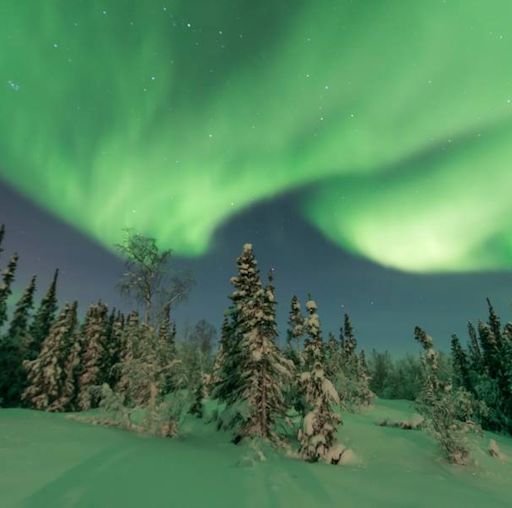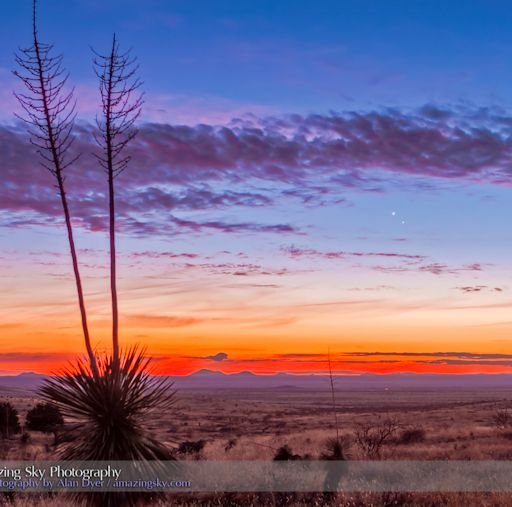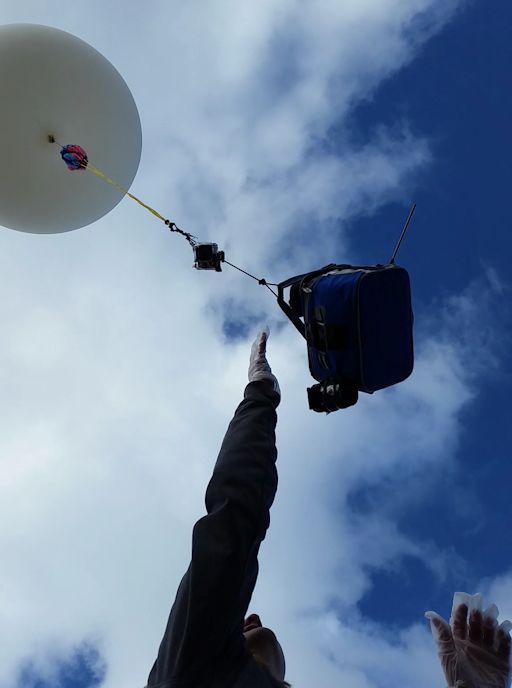Learn to photograph Northern Lights like a pro. Sign up for Peter Rosen's Aurora Photo Courses in Abisko National Park. | | |
QUIET WITH A CHANCE OF FLARES: Solar activity is low. However, three sunspots (AR2255, AR2257, AR2259) have unstable magnetic fields poised to erupt. NOAA forecasters estimate a 40% chance of M-class flares on Jan. 11th. Solar flare alerts: text, voice
GREEN SNOW: The next time you're in Northwest Territories of Canada and the snow at your feet turns green, look up. The sky overhead is probably even greener. Spaceweather.com reader Ryan Fisher and his daughter experienced the phenomenon last night:

"After 5 yrs of trying to share aurora with my daughter, on our first night in Yellowknife the whole sky blew up with green for several hours," says Ryan. "It was a night we will never forget."
The source of the display was a magnetic fluctuation in the solar wind. In the jargon of space weather, "the IMF tipped south." This opened a crack in our planet's magnetosphere. Solar wind poured in and ignited the auroras.
It could happen again tonight. Solar wind conditions are disturbed, and the IMF has been fluttering south for more than 24 hours. NOAA forecasters estimate a 30% chance of geomagnetic storms on Jan. 11-12. Aurora alerts: text, voice
Realtime Aurora Photo Gallery
SUNSET PLANETS: The sunset planet show is still underway. When the sun goes down tonight, step outside and look west. Venus and Mercury are shining through the twilight less than 1o apart. Alan Dyer photographed the conjunction on Jan. 10th from the City of Rocks State Park in New Mexico:

"Mercury is nearing its greatest angle away from the sun and will remain near Venus for the next week," says Dyer. "Mercury is very easy to sight with unaided eyes. If you have not seen the innermost planet, this weekend is a good chance to check it off your 'to see' list."
Dyer adds "a fact to keep in mind: both planets have probes orbiting them, but both are nearing the end of their missions. Europe's Venus Express has ended its mission and is about to make its final plunge into the dense Venusian atmosphere. At Mercury, NASA's Messenger probe has gained a small reprieve, with it now expecting to impact on Mercury at the end of April, a month later than expected."
Two bright planets + two doomed spacecraft = one amazing sunset. Take a look!
Sunset Planets Photo Gallery
THAI PEPPERS GET 'SPACE RADIATION TREATMENT': Yesterday, Jan. 10th, Spaceweather.com and the students of Earth to Sky Calculus launched another Space Weather Buoy. The purpose of the flight is to monitor cosmic rays, which are slowly rebounding from a sudden drop in late December 2014. In addition to the usual radiation sensors, this Buoy contained nearly a thousand hitchhikers: Thai pepper seeds. The students wanted to know if peppers exposed to high-altitude radiation are "hotter" than a control sample on the ground. To find out, they sent hundreds of the seeds to the stratosphere:

The payload has since traveled more than 100,000 feet high and parachuted back to Earth in the Death Valley National Park. En route, the seeds were exposed to radiation levels more than 40 times Earth-normal--a dose of cosmic rays similar to what you would get on the surface of Mars. On Jan. 11th, a team will hike into the desert not far from the stunning Eureka Dunes to recover the payload, its data, and pepper seeds. Stay tuned for updates.
Realtime Space Weather Photo Gallery
Realtime Comet Photo Gallery
Every night, a network of NASA all-sky cameras scans the skies above the United States for meteoritic fireballs. Automated software maintained by NASA's Meteoroid Environment Office calculates their orbits, velocity, penetration depth in Earth's atmosphere and many other characteristics. Daily results are presented here on Spaceweather.com.
On Jan. 11, 2015, the network reported 6 fireballs.
(5 sporadics, 1 alpha Hydrid)

In this diagram of the inner solar system, all of the fireball orbits intersect at a single point--Earth. The orbits are color-coded by velocity, from slow (red) to fast (blue). [Larger image] [movies]
Potentially Hazardous Asteroids (
PHAs) are space rocks larger than approximately 100m that can come closer to Earth than 0.05 AU. None of the known PHAs is on a collision course with our planet, although astronomers are finding
new ones all the time.
On January 11, 2015 there were potentially hazardous asteroids.
Recent & Upcoming Earth-asteroid encounters: | Asteroid | Date(UT) | Miss Distance | Size |
| 2014 YE42 | Jan 3 | 4.3 LD | 88 m |
| 2014 YP34 | Jan 4 | 8.8 LD | 26 m |
| 2007 EJ | Jan 12 | 68.9 LD | 1.1 km |
| 1991 VE | Jan 17 | 40.6 LD | 1.0 km |
| 2004 BL86 | Jan 26 | 3.1 LD | 650 m |
| 2008 CQ | Jan 31 | 4.8 LD | 36 m |
| 2000 EE14 | Feb 27 | 72.5 LD | 1.6 km |
Notes: LD means "Lunar Distance." 1 LD = 384,401 km, the distance between Earth and the Moon. 1 LD also equals 0.00256 AU. MAG is the visual magnitude of the asteroid on the date of closest approach. | | The official U.S. government space weather bureau |
| | The first place to look for information about sundogs, pillars, rainbows and related phenomena. |
| | Researchers call it a "Hubble for the sun." SDO is the most advanced solar observatory ever. |
| | 3D views of the sun from NASA's Solar and Terrestrial Relations Observatory |
| | Realtime and archival images of the Sun from SOHO. |
| | from the NOAA Space Environment Center |
| | the underlying science of space weather |

